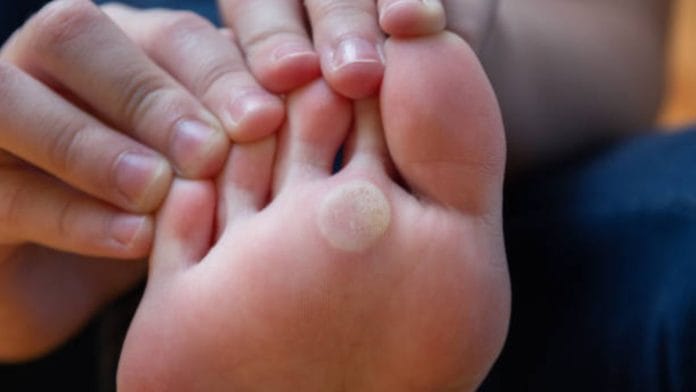This week’s damp, muggy weather calls for a closer look at two of the season’s most annoying foot invaders: corns and warts.
At first glance, they look the same, but they’re not.
Warts are little rough, grainy bumps caused by HPV (yep, the same virus family that can cause trouble in intimate body parts). On the bright side, these usually stick to your hands and feet.
The easiest way to identify a wart is by pressing it from the side; if it hurts, then it’s probably a wart.
Warts usually have a grainy texture with tiny black dots on them—these dots aren’t dirt but clotted blood vessels. So, don’t try to scrub them away. And warts often show up in clusters, as well as a solitary growth, although the latter is quite rare.
Here’s another factoid for you—warts can grow months after exposure to shared objects, such as towels and other pieces of cloth. You might not get them at all if you’re blessed with a strong immune system because your fights off the virus before it settles in.
What are corns?
Corns, on the other hand, are thick, hardened layers of skin on your feet that form from constant friction or pressure—usually caused by ill-fitted shoes, poor foot alignment, or lots of walking.
How to identify corns?
- They are hard and raised bumps, often on your toes and soles.
- It’s surrounded by dry and very flaky skin.
- It’s got a callus-like texture.
You’re more susceptible to getting corns on your feet if any of these apply to you:
- You regularly wear tight shoes.
- You have recently switched to a new shoe style.
- You have flat feet, bunions, or hammer toes.
- You have diabetes—poor circulation can make foot issues more serious.
How to get rid of warts?
Cryotherapy: Liquid nitrogen (–320°F!) is sprayed or dabbed on the wart, freezing and killing the infected tissue, and then removed by a medical professional.
The process is quick, effective, and widely available. But it might take you multiple sessions and might sting, like an ice burn.
Strong acids: Salicylic acid often helps dissolve the wart layer by layer. And you can apply it at home after consulting with your dermatologist.
Surgical removal: A licensed doctor or dermatologist will burn the wart’s blood supply—no oxygen means the wart dies. Then, they’ll remove it through a procedure called “curettage” (basically scraping it off).
While this is a quick fix, it can also be expensive and might leave you with a tiny scar as well. And mind you, all of these methods need to be consulted with your trusted and licensed dermatologist or doctor, first—especially if you’re pregnant.
Here’s another pro tip: Don’t share shoes, nail clippers, or towels with someone who has warts. You must also never pick at your warts—while I understand the mental validation that might give you, you’re not helping yourself and will probably end up with a wart army.
Cure for corns
Corns can generally be managed with a few healthy choices that always start with keeping the comfort of your feet at the forefront. Here’s how:
Space for toes: Wear shoes that offer enough wiggle room. If your toes feel cramped, your shoes are too tight. If your feet slide around, they’re too loose.
Soak and file: Warm water + pumice stone = smoother feet. Remember that this needs to be done consistently.
Moisture: Dry skin makes it a lot easier for corns to survive on your skin. So, always make sure your feet are moisturised with some thick foot cream, preferably urea or lactic acid-based.
If you’re diabetic, please consult with your trusted doctor who can assist you with trimming it down.
Also read: From botox to laser treatments—how to get a facelift without surgery
Who’s most at risk?
Wart magnets:
- Kids and teenagers are at risk because their immune systems are still figuring things out.
- People more prone to HIV, diabetes, and people with a lot of stress in their day-to-day lives, etc.
Corn magnets:
- People who prefer flip flops to closed-toed shoes.
- People with club feet.
- People who skip regular foot care: If it’s been a while since your last pedicure or basic foot maintenance, you might get corns.
Dr Deepali Bhardwaj is a Consultant Dermatologist, Max Hospital, Saket. She is also an anti-allergy specialist, laser surgeon and internationally trained aesthetician. She tweets @dermatdoc. Views are personal.
(Edited by Ratan Priya)






